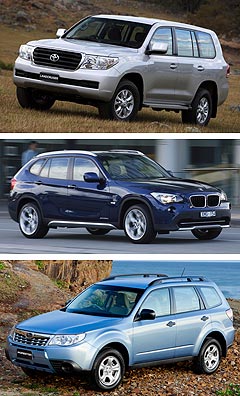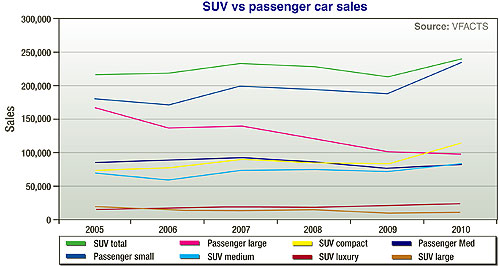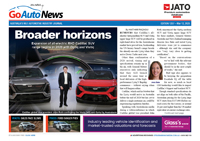News - Market Insight - Market Insight 2011SUVs close to becoming Australia’s favourite carNumber one: Toyota Prado was number one in the medium SUV segment last year with 13,180 sales. Small cars almost toppled by SUVs as Australia’s top-selling vehicle type in 20107 Mar 2011 AUSTRALIA’S love affair with the sports utility vehicle showed no sign of cooling off last year as SUV sales grew by 25 per cent – far faster than any other segment – and accounted for 22.7 per cent of the market, coming within 3906 units of toppling small cars as the nation’s most popular vehicle category. The perpetually declining large car segment was overtaken for the first time by a 36.6 per cent boom in sales of compact SUVs last year, which leapt by almost 31,000 units to 114,761. Similarly, the medium SUV segment grew in 2010 by over 11,000 units – or 16.1 per cent – to outstrip the popularity of medium-sized passenger cars, sales of which grew more slowly at 7.8 per cent year-on-year. Year-to-date in 2011, compact SUVs are still 5895 sales ahead of large cars while medium SUVs lead medium-sized cars by 1058. But small cars are having a resurgence, with 38,826 units YTD against combined small SUV sales of 35,948. In the space of five years, the gulf between sales of SUVs and those of small cars narrowed from 48,511 units to fewer than 4000 – with the gap narrowing sharply by 21,929 sales between 2009 and 2010 alone. Last year, Toyota had a 1-2 finish in the medium SUV segment with its Prado (13,180 – up 27 per cent) and Kluger (13,117 – up 2.1 per cent) while taking a dominant 70.4 per cent slice of the large SUV category with 9050 sales of its 200 series LandCruiser, up 16.7 per cent in a segment that grew 11.3 per cent.  From top: 200-series Toyota Landcruiser, BMW X1 and Subaru Forester. From top: 200-series Toyota Landcruiser, BMW X1 and Subaru Forester.The Japanese giant also came a close second in the compact SUV arena, shifting 12,635 RAV4s to trail the Subaru Forester by just 47 units. RAV4 sales for the year grew 15.5 per cent against the Subaru’s 6.5 per cent. Of course the SUV figures do not include dual-cab 4WD utes, which are often used as an SUV by private buyers. With those included, the off-road style of vehicle is by far Australia’s favourite. The 4X4 ute market grew 9.5 per cent last year, to 85,813 units. So far this year, the segment is up 10.7 per cent, while 4x2 utes are down 11.9 per cent, continuing 2010’s downward trend that saw the category shrink by 12.4 per cent. Despite poor comparisons with passenger cars in terms of fuel economy, ride, handling and performance, plus derision from some members of the public, the popularity of SUVs is due in no small part to practical considerations. Even where any real or suggested off-road ability is irrelevant, SUVs offer the perception – but not necessarily the reality – of higher occupant safety, an elevated view of the road ahead and greater immunity to potholes, kerbs, speed bumps and steep road cambers or ramp inclines that can graunch the undersides of low-slung cars. BMW Group Australia head of corporate communications Piers Scott told GoAuto: “Customers like the space, comfort and commanding ride height. The popularity of our two-wheel drive X1 shows that it is the vehicle proportions over the four-wheel driving capability that matters to most customers.” In Australia, with a road network designed for carrying large cars, the size of SUVs rarely poses a problem on the road and their generous dimensions provide extra space for large families or people whose hobbies require them to carry bulky equipment, while often looking more stylish than equivalently-spacious people-movers or wagons. SUVs also offer the flexibility of exploring Australia’s thousands of kilometres of unsealed roads that are intolerable in most conventional cars. In addition, the recent series of natural disasters makes a decent SUV feel like a safer bet as they are more suited to harsh environments – not to mention that many Aussies like to hitch up a trailer, boat, camper or float, a task for which a high towing capacity is preferable, if not essential. Toyota Australia public relations manager Mike Breen agrees: “Interior space is important, flexible seating and cargo-carrying ability for surfboards, mountain bikes, family gear and so on, along with a vehicle that often has more style, street-cred and on-road presence than the alternatives. In many respects, they are the modern station wagon, but without the negative connotations of that phrase. “SUVs also offer the possibility of travelling to places that cars cannot go – due to better ground clearance as well as the availability of four-wheel drive. In regional and rural areas, large SUVs are popular because of their size, comfort and relaxed motoring, especially when travelling large distances on rough roads.” Asked why Toyota remains a dominant player in the SUV sector, Mr Breen said that, in addition to the brand’s reputation for quality and wide SUV range – that is about to expand further this month with the arrival of the FJ Cruiser – its extensive dealer network “provides reassurance for buyers, no matter where they live or travel”. Not taking into account Land Rover’s all-SUV line-up, the luxury SUVs accounted for an average of 37.9 per cent of Australian sales for their manufacturers. Volvo’s XC range accounted for two-thirds of its volume last year and almost half of all Porsches sold in 2010 were Cayennes. Nearly four in ten Lexus purchases were for an SUV, more than a third of BMWs wore an X badge and 27 per cent of Audi customers opted for a Q5 or Q7. Only Mercedes bucked the trend, with just 14 per cent of Benz buyers seeking an SUV. Commenting on the disproportionate popularity of SUVs in the luxury sector, Mr Scott said that “overwhelming” customer feedback pointed to the fact that BMW’s luxury SUVs – a concept the brand claims to have invented with the X5 – “offer stylish practicality without any trade-off in terms of agility or performance”. He also added that the successful BMW X1 is “luring customers from the non-premium brands who may not have otherwise considered a BMW” and that the Bavarian brand’s compact SUV “has proven extremely popular with customers who may have previously driven a BMW sedan or Touring and wanted a little more space or ride height”. Recent advances in technology have significantly reduced the fuel consumption and CO2 emissions of SUVs, with luxury brands offering some of the most notable improvements. For example, the latest Range Rover TDV8’s fuel consumption is down 18.5 per cent to 9.4L/100km while CO2 has dropped 14 per cent to 253g/km, Audi’s updated Q7 with the 3.0-litre TDI engine saw fuel consumption drop 19 per cent to 7.9L/100km (CO2 down from 239g/km to 205) and BMW’s latest X3 in xDrive20d spec sips 5.6L/100km while pumping out 147g/km – identical figures to the Aussie-built Holden Cruze diesel. These improvements are all well and good, but when the technology is subsequently applied to passenger cars, the SUVs can’t hide their extra weight and bulk. The new Audi A6 – due to arrive Down Under in July – with all-wheel drive and powered by a 3.0-litre V6 diesel similar to its Q7 stablemate, uses 6.0L/100km while emitting 158g/km of CO2, some 24 per cent and 23 per cent lower respectively than the SUV. The Australian appetite for SUVs is worrying car companies who are facing the prospect of legislation bringing in mandatory CO2 targets, which could follow the European model and measure the average CO2 output of cars registered by each company over the course of a year, fining them for every gram they step over the target. Mr Scott suggested that a scenario could develop in Australia where the car companies are penalised for the choices made by their customers because, despite a wide choice of low-emission vehicles on offer, this is offset by the fact that car buyers are increasingly opting for SUVs.  Read more22nd of February 2011  Australian CO2 tailpipe emissions fallNational CO2 average falls 2.7 per cent in 2010 as new mandatory targets draw near3rd of September 2010  August VFACTS: SUVs drive market 12 per cent higherPrivate buyers and SUVs continue to drive this year’s new-vehicle market3rd of August 2010  SUVs drive 2010 sales boomThis year’s new-vehicle sales surge in Australia is led not by cars but SUVs |
Click to shareMarket Insight articlesResearch Market Insight Motor industry news |
















Facebook Twitter Instagram